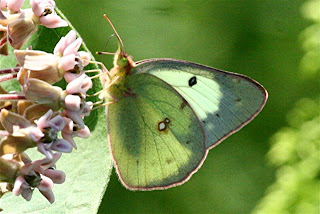
Yesterday, hoping to find Monarch butterflies, I decided to check out a Milkweed Patch a few miles away where I had found Monarchs last summer.
.jpg) En route
En route, while passing a large meadow along the way, I saw an
adult male Northern Harrier coursing the area and got a distant photo of it before it flew from view. Arriving at the Milkweed Patch I found
two beautiful Monarchs. the photo of the one shown above is a male Monarch. Perhaps I shall return there today and search for signs of eggs or caterpillars.

Last year I raised a Monarch Caterpillar and was able to observe it change into a beautiful adult butterfly. On the gravelled shoulder of the road nearby I saw a very vibrant, yellow,
Orange Sulphur Butterfly and patiently waited for it to settle so as to get its picture. Before returning home I drove to a small lake in the vicinity and just as I stopped my car I saw an
Osprey plunge into its waters.

Not having my camera ready I watched while it rose from the water,
unsuccess -ful in its hunt. Perched in a group of Birches over the water was an
Eastern Phoebe and on some hummocks of grass in the low waters near the shore I caught a glimpse of a few gleaming
domes of Painted Turtles basking in the sun. All enjoyable sightings.
.jpg) The markings of the Clouded Sulphur Butterfly are similar to those of an Orange Sulphur, however, there is no orange on this butterfly and the yellow colour is very light and almost faded looking. As well, the post median markings on the hind wing do not seem as prominent as those of a Orange Sulphur.
The markings of the Clouded Sulphur Butterfly are similar to those of an Orange Sulphur, however, there is no orange on this butterfly and the yellow colour is very light and almost faded looking. As well, the post median markings on the hind wing do not seem as prominent as those of a Orange Sulphur. .jpg) At first I thought perhaps this might be a Pink-edged Sulphur as the pink edging and head on this butterfly is very rich, however, the central spot on the hind wing of this butterfly is double whereas the spot on the hind wing of the Pink-edged would be a single one. Also the Pink-edged Sulphur has no hind wing postmedian spots.
At first I thought perhaps this might be a Pink-edged Sulphur as the pink edging and head on this butterfly is very rich, however, the central spot on the hind wing of this butterfly is double whereas the spot on the hind wing of the Pink-edged would be a single one. Also the Pink-edged Sulphur has no hind wing postmedian spots.





.jpg)
.jpg)
.jpg)
.jpg)
.JPG)
.JPG)

.jpg)
.jpg)
.jpg)

.JPG)
.jpg)
.jpg)

.JPG)
.jpg)
.jpg)


.jpg)

.jpg)


.jpg)
.jpg)
.jpg)

.jpg)


.jpg)
.jpg)


.jpg)

.jpg)


.jpg)
